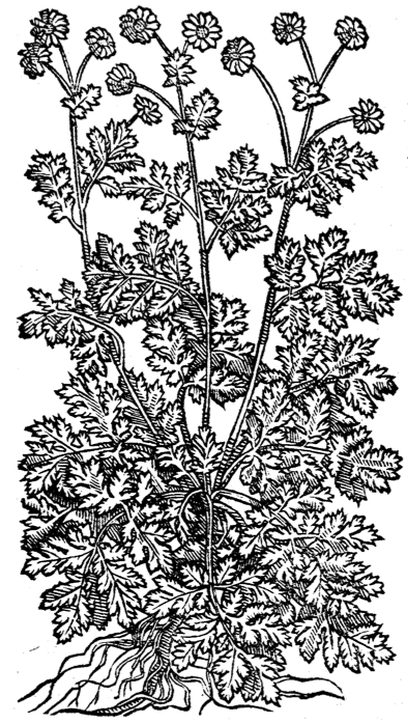Tanacetum Parthenium, FeverfewParthenium, Matricaria, FebrifugaUqhuwan (Unani) |

|
|
|
 Dioscorides Materia Medica, Mathias, 1563
Dioscorides Materia Medica, Mathias, 1563 |
Botanical name:
Tanacetum parthenium (previously Chrysanthemum parthenium, Matricaria parthenium, Pyrethrum parthenium)
Parts used:
Herb
Temperature & Taste:
Cool (Warm in the West), dry. Bitter, Pungent
Classifications:
2D ATTENUATERS OF CONGEALED BLOOD
3G. EMMENAGOGUE
4i. UTERINE
Uses:
1. Moves the Blood, Clears Wind-Heat, Eases Pain:
-acute Fever with Headache, body aches, Cough etc.;
-acute Cold and Flu with Heat symptoms
-“Of Great force in Migraine, Vertigo, and Headache” (Salmon); principally used for Migraines in modern herbal medicine.
-“In the worst headache, this herb exceeds whatever else is known” (John Hill).
-Sciatica, Facial Neuralgia, and Dizziness.
-acute Arthritis and Rheumatism.
-“It promotes perspiration”. (Avicenna)
2. Calms the Mind, Regulates the Qi:
-Sadness, Depression, Melancholy, lowness of the Spirits;
-paradoxically for Nervousness, and to calm those prone to Fits of Rage, Anger, Mania or sudden outbursts.
-Restless or Fretful children.
3. Moves the Blood and Qi, Clears Stasis, Promotes Menstruation:
-strengthens and cleanses the Womb.
-sluggish menstruation, Amenorrhea, Dysmenorrhea;
-‘strangling’ or ‘Rising’ of the Uterus
-Hardness or Inflammation of the Womb.
-promote Birth, expel the Afterbirth
-helps regenerate the womb after childbirth, and to ‘remedy such infirmities as a Careless Midwife has there caused’. (Culpeper)
-prevents Miscarriage
-Female Sterility.
-often decocted in wine; boiled in wine for pain, hardness and obstruction of the uterus.
4. Clears Phlegm, Stops Coughs:
-Cough, stuffiness of the Chest, shortness of Breath, difficulty breathing and Wheezing
-good for ‘Lungs stuffed with phlegm’. (Gerard)
-“It purges out black bile and phlegm”. (Avicenna)
-decocted in Honey Water or taken with Oxymel
5. Promotes Urine, Clears Stones:
-difficult or obstructed urine
-good to cleanse the Kidney and Bladder
-Gravel and Stones.
6. Resists Poison:
-‘Special remedy against the overuse of Opium’
-similarly used for Henbane and Tobacco poisoning.
7. Externally:
-relieve all types of heat and inflammation.
-distilled water was used externally to remove Freckles.
-fresh herb used in poultices has been applied to Lumps and Tumors of the Breast.
-paste made with salt applied to the wrists cures Agues.
-topically as an insect repellent (diluted tincture)
-leaves warmed in a fry pan and applied to the back of the head were said to relieve Migraine. (Medicina Britannica, Thomas Short, 1746)
-“useful in Fistula”. (Avicenna)
Dose:
1. ‘It is chiefly given in Decoction’
2. Often used in low doses, especially as a prophylactic for Migraine.
INFUSION or BRIEF DECOCTION: 2–6 grams (dried), or 1–2 teaspoonfuls (dried) per cup, or 2–5 fresh or frozen leaves (or ½ oz. steeped in 500mls boiling water, taken in half cupful doses 3 or more times daily)
FRESH LEAVES: 2-5 fresh Leaves eaten daily is a typical traditional dose
TINCTURE (1:5 in 25% alcohol): 5–20 drops, up to 4 or 6 mls, 2–3 times daily
POWDER: 1–3 grams (250mg taken as a prophylactic against Migraines)
FLUID EXTRACT (1:1 in 45% alcohol): 1–2mls., up to 3 or 4 mls.
Main Combinations:
1. Headache and Migraines:
i. Feverfew with Betony and Vervain
ii. Feverfew with Betony, Balm and Valerian
iii. Feverfew with Siler Montane and Lovage
iv. Feverfew with Betony, Vervain, Balm and St. Johns wort (as in Betony Infusion Compound)
v. Migraine prophylaxis, Feverfew, Willow
vi. Migraine prophylaxis, Feverfew, Ginger (sublingually, proven effect)
2. Fever:
i. Feverfew with Camomile and Peppermint
ii. Feverfew with Wormwood, Centuary, Calendula, Tormentil, Blessed Thistle, Camomile and Dandelion (as in Fever Water)
3. Wind diseases such as Apoplexy, Falling Sickness, Cramps, Convulsions, Vertigo, Dizziness, Feverfew with Sage, Rosemary, Borage, Balm, Orange flower, Peony, Cinnamon, Nutmeg, Sandalwood, Pearl (as in Spirit of Lavender)
4. To promote Menstruation, Feverfew with Mugwort, Pennyroyal, Balm (as in Decoction to Promote Menstruation)
5. Dysmenorrhea with strong pain:
i. Feverfew with Pennyroyal and Cannabis
ii. Feverfew with St. Johns wort, Savin, Peony, Rue and Costus
6. Hysteria, Feverfew with Peony root, Mistletoe, Zedoary, Lovage root, Myrrh (Lazarus Riverius)
7. Menopausal Hot flushes, Feverfew with Sage and Yarrow
8. Infertility, Feverfew with Broom flower, Celery seed, Cumin, Mugwort, Feverfew Aloe, Saffron (as in Pills Against Barrenness)
9. To bring down the Lochia, Feverfew with Camomile and Mugwort
10. Pain due to Blood stagnation, Feverfew with St. Johns wort, Peony, Rue and Costus
11. Ointment for Bruises, Feverfew with Plantain, Sage and Bugle, heated in unsalted butter.
12. Salve for Tumors and Cancer of the Uterus, (infused) Oils of Wallflower, Feverfew, Saffron, Myrrh, Opopanax, Turpentine, made into a salve with Celery juice (Wirtzung)
Major Formulas:
Betony Infusion Compound
Decoction to Promote Menstruation (Wirtzung)
Syrup of Mugwort (Augustana)
Pills Against Barrenness (Turner)
Cautions:
1. Generally not used during Pregnancy; it has occasionally been used for Threatened Miscarriage
2. Not used in Hot and dry (Yin deficient-Heat) bodies
3. Avoid in bleeding disorders and heavy menstruation.
4. Some people are allergic
Drug Interactions:
Possible interactions with anticoagulant and blood-thinning medicines may occur.
Main Preparations used:
Distilled Water; Tincture
-
Extra Info
- Research
